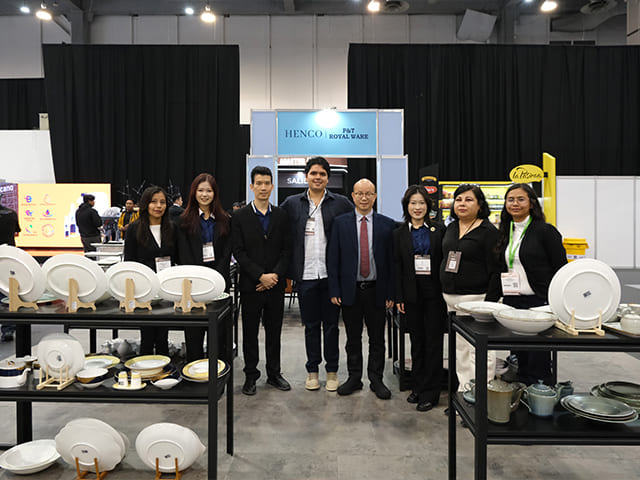Bone china and fine china are two types of classical tableware materials that usually occur on our table. Both of them are so delicate that people at home and aboard have been attracted and charmed since they were born. And, have you exactly know details about them? Are they both from china? What are the differences between them? What type of china should I buy if I want a set of beautiful china for dinner?
What Is Bone China?

(Source: Pinterest)
Bone china is was invented by Thomas Frye in British in about 1800. To our surprise, it was a complete fortuity. After bone powder was added into Kaolin, Thomas found that the finished china was more transparent and solid than before. This unexpected improvement was, later, researched in detail by Josiah Spode. As a result, initial formula, which contained 60% bone powder and 40% Kaolin, was launched. After much development embracing the intelligence across two ages, the official standard bone china formula, which contains 50% bone power, 25% kaolin and 25% clay, is generally acknowledged by local British nowadays.
The manufacture procedure of bone china is not very complex. First, basic shape should be made prior to high-temperature calcining at 1250 degree. Generally speaking, china green body may shrink 7% to 20%, so it would be better to calcine it in a specific mould in order to keep original outline. Then, checking its size, grinding surface and spraying glaze are vital steps before next calcining – 1150 degree glaze heating. The third step is colouring. Autographic printing paper should be attached on the surface of white china and then calcine at 820 degree. Finally, after careful checking, a delicate bone china is finished.
What Is Fine China?

(Source: Pinterest)
China could not be regarded as fine china until 1700 when Xi Jin dynasty comes. At that time, Xi Lu country, which is in Henan Province, China, produced a type of china with smooth and polished characteristics. That is very similar to the fine china we can see now.
There are a lots of strict quality requirements for fine china. For example, whiteness should not be lower than 70%. And, water absorption ration should be lower 0.5%. Moreover, the color should be pure when its body should be thin and polished. More importantly, the shape should be decent.
In order to realize such high quality, the manufacture procedure is accordingly more complicated. The first step is china clay trituration, which outputs fine powder. Secondly, the fine powder will go through several filter pools. Those come out from the last filters are made into graceful shape by skillful artists. Next, elegant patterns are sculptured on the surface by the artists, too. After glazing, the green body would be calcined at 1350 degree.
Bone China Properties

(Source: Pinterest)
1. Creamy White and Transparency
Because of mixture of bone powder and proper calcine temperature, bone china looks creamy and transparent, which is a symbol of nobility.
2. Light Weight
Due to its raw material, it can be made in thin thickness. So the weight is lighter than most of china. However, pursuit of thin thickness may greatly improves defective percentage of bone china, which causes high market price.
3. Percussive Sound as Bell Tone and Good Hardness
When it comes to tableware, most of people may just see it as a dish that contains food. However, bone china is more than containing food. It can make pleasant percussive sound if there is any touching on it. That may provides an extra good mood to the dinner. Anyway, if it is not in a good hardness, each percussing is a risk for the table ware. Bone china, with 6.5-7 hardness in average, is strong enough to handle daily touching.
4. Green Material

(Source: Pinterest)
Heavy metal is very harmful for physical health and environment. Over consumption of heavy metal may cause encephalopathy and amyotrophy. Moreover, the pollution of heavy metal against natural environment is so serious that it is very difficult to recover. Thus, bone china is very friendly in this way with heavy metal free.
As tableware material that serves to meals, choosing bone china is definitely proper. Main ingredient of bone china is calcium oxide, which does no harm to physical health. Plumbum and cadmium is not contained. You can enjoy your dinner without worrying about food pollution. With the raising of green awareness, more and more people prefer to use bone china nowadays.
5. User-Friendly Outline

(Source: Pinterest)
Most of design of bone china are in European style. Dish decorated by golden edge, cup with famous building patterns in gold are very common design.
The shape of bone china tableware is in western style, too, such as goblet, hand pinch bowl. It is a smart and elegant design which considers about practical use and beauty appearance. As we mentioned above, bone china tableware is thin, which, from other perspective, may result in bad heat insulation. To the point, shapes, like goblet, pinch bowl or cup with handle, release our hands from direct touch to the hot surface. In this way, it may be safer.
6. Careful Maintenance
Some bone china with golden decoration could not be put into microwave oven. And for all bone china , commonly, wash agent applying to bone china, should be between 11 to 11.5 PH. Washing temperature should not over 80 degree. If there is scratch on its surface, toothpaste is suggested to patch it. If there is tea stain, using lemonade to remove it is the best solution.
Fine China Properties

(Source: Pinterest)
1. Pure White and Transparency

(Source: Pinterest)
Generally speaking, fine china, calcined in weak reduction atmosphere, presents a type of pure white with little teal blue. This color is so peace and smooth that brings quiet and beautiful features to fine china. Besides, its transparency promotes the appearance of fine china lamp, where the light inside romantically illuminates the pretty patterns on the surface.
2. Enduring Color
Thanks to above 1300-degree-calcine, the color of fine china can remain above a hundred year. Therefore, people prefer to collect fine china than bone chine.
3. Good Hardness
Fine china usually made through two calcine processes. One is conducted before glazing, the other is after glazing. The former calcine process oxidates organ matter and reduced crystal water. The hardness of fine china, from 6.5 to 7, is ensured by above processes.
This is also the reason why scratch resistance of glaze of fine china is greater than common china.
4. Traditional Exquisite Patterns

(Source: Pinterest)
Fine china originates from China, therefore, its pattern is very traditional and elegant. Flower, bird and even poem can be the decorative pattern for fine china, which is also a carrier of Chinese culture.
Which is Better as Home Tableware and Why?

(Source: Pinterest)
For home tableware, bone china is more recommendable. Due to its light weight, servicing meals and washing dishes is convenient for household women and users. Most of bone china is designed in a friendly-using shape. Big handle of cup and big knob of teapot bring great convenience when you are having meals.
Second, creamy white is a warm color which suitable to occur on family dinner, promoting an good atmosphere. Besides, the transparent appearance is also decoration for the dinner table, bring more sense of beauty during eating. Furthermore, percussive sound as bell tone with echo provide a soft mood during dish preparation or during dinner. Bone china dinnerware, to some extent, is indispensable tableware for a wonderful family dinner with its capabilities of pleasing your vision and hearing and setting off the yummy food.
Third, compared to fine china, bone china might be physical safer because of exclusion of heavy metal. In this way, meals on china tableware would not be pollution, ensuring your health.
Fourth, bone china is in great hardness. What’s more, the maintenance method is not too difficult to realize by household woman with common household tool. We believe that it can play an reliable roles and handful assistant in housework.
Which Is Better as Commercial Tableware and Why?

(Source: Pinterest)
For commercial tableware, I think fine china is worthwhile. Compared to bone china, fine china can keep its pure white for a long time due to special raw materials. That means it can be collected for appreciation. For example, if you purchase a fine china ware, you can sell it at a good price easily even ten years later, without color fading.
What’ s more, scratch resistance of glaze is another features that fit fine china in commercial application. As we all know, smooth surface and elegant patterns are very important factors that affect beauty of the whole china tableware. No purchaser and collector like a china tableware with abrasion. Therefore, picking fine china is a good idea for appreciation and commercial collecting.
Besides, the pattern of fine ceramic china is based on Chinese culture. Image like phoenix, peony, Ruyi and Xiangyun(two types of Chinese traditional line patterns) is not just a bird, a flower or a series of line. They imply luck, harmony, and rich. Many people like keeping these elements to pray for better life. This implication also improves the commercial value of fine china.
Last, for white china, any stain certainly could be a fatal factor that affects its appreciation value and commercial value. Moreover, fine chine, with 0.5% low water absorption, doesn’t absorb any dirt water, resulting in few dirt penetration and easy maintenance. From other perspective, the commercial value would not exposed to the risk of large decline.
Conclusion
Bone china and fine china are both the symbol of elegant, decency and honor. Both of them are high-standard materials for tableware. Full understanding of these two type of china may help you make full use of them and well promote your life.

